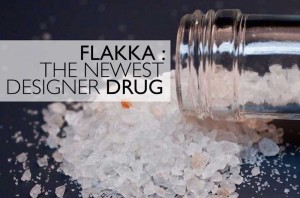
Not Even Once
Is Flakka as Dangerous as it Sounds on the News?
Yes and no, but mostly yes. Let’s start with what exactly flakka is. Flakka is alpha-pyrrolidinovalerophenone, but let’s call it A-PVP. A-PVP is a cathinone. Flakka is a Schedule I Controlled Substance under Florida Statute Chapter 893.03 which means that there is no currently accepted medical use for it and the potential for abuse is high. It is also a Schedule I controlled substance on the Federal Register which has essentially the same criteria. The terms A-PVP and flakka will be used interchangeably throughout.
Disclaimer:
There are some of you who may read this and can speak nerd/science jargon better than I can. Not many, but some. You will inevitable go back onto a drug bulletin board saying that I don’t know what I am talking about and spreading misinformation, we should be having a consultation. Delivering information that it not hyper-analytical so it can be processed by the public is neither ignorant or misleading. While this might not be PhD level chemistry or pharmacology information, it was not intended to be. The only point I am trying to get across is DON’T USE THIS CRAP!
Misinformation on Flakka
The only stories that you hear on the news are the truly bizarre incidents. So keep in mind that the local news only shows stories that sensationalize the topic. You will never hear “BREAKING NEWS AT 6 O’CLOCK! High School Student Kevin Smokes Flakka and Says it was Pretty Cool, but Wouldn’t do it Again!” Instead you will hear “BREAKING NEWS AT 6 O’CLOCK! MAN ON $5 DRUG THAT CAUSES INSTANT INSANITY IMPALES NUTSACK ON FENCE POST! ZOMBIE APOCALYPSE IS UPON US!”
Flakka and the current flakka hysteria is similar to bath salts and how bath salts were viewed and portrayed just a few years ago. Remember when bath salts were going to turn people into flesh eating zombies? There was the Miami cannibal attack that turned out to be a case of “this dude is crazy” rather than bath salt intoxication? Yet, that didn’t stop the bath salt hysteria. There is also my personal favorite, a man in Pennsylvania got out of his car, ran down the street into an occupied residence(thereby committing a felony), was chased out of said house and jumped onto a police car causing damage to the police vehicle. Why? Because he was high on bath salts, believed his car was melting and that he was being chased by electricity.
So enjoy the news for what it is. It is not an accurate depiction of the ordinary experience. Watch this video and take a look at the recent “newsworthy” flakka incidents in South Florida.
The Sun-Sentinel is an extremely reputable and reliable news source in South Florida. What did it show? A guy running naked in the middle of an intersection, a guy trying to break into the police department, a guy diving over a spiked fence with no regard for the safety of his testicles, some guy running around naked on his roof and some truly despicable person that attacked an old lady in her home when he was high. I’m not going to bother to look, but chances are that guy had a violent history to begin with. So the media’s portrayal of flakka is skewed.
Q: Ok, so if we are being mislead and Flakka isn’t that dangerous, it is OK to try it right?
Let’s Hear from Broward County Sheriff Scott Israel
“In my 36 years in law enforcement, I’ve never seen a drug this dangerous.”
Q: “I know, but he is the Sheriff and he has to say drugs are bad. Is he exaggerating?”
A: No. He is not. Flakka really is that bad.
Anybody who knows me knows that I wouldn’t say that if I didn’t truly believe it. I’ll spare everybody the speech on unregulated Chinese laboratories and quality control. The manufacturers appear to be doing a fantastic job. Make no mistake about it, I firmly believe that A-PVP and its predecessor MDPV are two of the most, if not the most, addictive substances on the face of the planet. While recovery from stimulant addiction is not nearly as debilitating as opiate addiction, the length of time from first use to addiction is faster. Cocaine is widely regarded as the drug with the quickest path to addiction. I disagree. In my experience concerning, flakka and MDPV, users go from experimenting to full blown addiction in a matter of days. While flakka won’t eat your skin away like homebrew desomorphine, it will still destroy your life. Quickly.
In order to understand why flakka is so dangerous you first need to understand the different types of commonly used recreational stimulants and how those stimulants affect your mind and your body. There are four(4) primary types of recreational stimulants. There is cocaine, amphetamines, methylphenidate and cathinone’s. Each of those classes has what are called analogs, isomers and/or derivatives which are structurally similar and have similar effects. We are going to ignore methylphenidate and its related compounds for this discussion. For some reason, there has never been much in the way of recreational use of cocaine analogs. However, they are freely available and, for the most part, are not scheduled controlled substances. For amphetamines there are different types of amphetamines such as methamphetamine, dextroamphetamie and 4F-amphetamine. There are literally hundreds of amphetamine analogs that are not scheduled and legally available. There is also a wide variety of substances that fall under the cathinone variety such as MDPV, BK-MDMA, Mephedrone, Methylone and even the antidepressant Wellbutrin. Some legal, some not.
How Stimulants Work
All stimulants work in essentially the same way. Stimulants increase the amount of three neurotransmitters in your brain. Those neurotransmitters are dopamine, serotonin and norepinephrine. Dopamine is believed to be the primary neurotransmitter affected by stimulants. Your body and mind associate dopamine with pleasure. The more dopamine that is present in your synapsis, the more pleasurable the activity. When you are taking part in a pleasurable activity your brain naturally releases more dopamine into your synapsis thereby making the experience pleasurable. As the pleasurable activity ceases to exist or ceases to take place the dopamine is reabsorbed and you go back to a normal mood.
When it comes to stimulants, there are two ways to increase the amount of dopamine in your synapsis. You can produce more thereby flooding the synapsis with dopamine. This is the way that amphetamines operate. Think of filling up a bucket with water. The bucket is the synapsis and the water is the dopamine. When you take methamphetamine, dextroamphetamine or any other type of amphetamine that chemical compound is telling your brain to pump more dopamine into the synapsis. (Note: I know that ALL amphetamines don’t necessarily act like this. Ecstasy is in the amphetamine class and it releases more serotonin than dopamine, but don’t be so picky and just humor me on this one.)
The second way to increase the amount of dopamine in your synapsis is by not allowing it to leave. Normally dopamine is released into the brain, does its job and is reabsorbed. Cocaine prevents dopamine from being reabsorbed. That makes cocaine a dopamine reuptake inhibitor. Cocaine will let dopamine in but will not let it out. Cocaine forces dopamine to remain in the synapsis and accumulate.
Synthetic Cathinones
There are numerous types of synthetic cathinones and not all of them work the same way. Certain synthetic cathinones, such as methylone, have a more serotogenic effect(huggy, kissy, cuddly) than a dopamine effect. However, the compounds related to pyrovalerone such as MDPV and A-PVP appear to focus primarily on dopamine and norepinephrine. The increase in norephinephrine is an important concern to law enforcement as norepinephrine provokes the “fight or flight” reaction in people. An increase in norepinephrine can lead to aggressive, hostile, violent behavior and purported acts of superhuman strength in agitated users.
Here is Why Flakka is so Dangerous
A-PVP, like its chemical cousin MDPV, acts as both a dopamine/norepinephrine release and reuptake inhibitor simultaneously. If using cocaine is compared to standing in a rainstorm for 15 minutes smoking A-PVP is the equivalent of standing and a thunderstorm for four hours. Flakka increases both dopamine and norepinephrine by pumping more dopamine and norepinephrine into the synapsis while at the same time preventing it from leaving. While cocaine is a short acting dopamine reuptake inhibitor, flakka is a longer acting reuptake inhibitor. While dopamine levels might not rise quite to the level that would be associated with cocaine use, the heightened levels of dompaine and norephinephrine, sustained for hours on end, can induce stimulant psychosis and negative physical side effects quickly. Due to the intensity of the drug, the compulsion to redose is extreme and tolerance develops very quickly. The prolonged heightened levels of norepinephrine quickly leads to increased heart rate, increase body temperature, grinding teeth and the other negative physical side effects. Onset of stimulant psychosis develops quickly due to several factors including, but not limited to, compulsive redosing, the sustained large amounts of dopamine in the synapsis and sustained high levels of norepinephrine resulting in decreased sleep. It is not uncommon to see stimulant psychosis appear within a matter of 2 days with MDPV or flakka.
This is a very basic overview. While you might not run down the street naked and get hung up on a fence by your crotch, even short term use can cause permanent neurological damage. If you are not familiar with the Montana Meth Project. Take a look at their videos. Same goes with flakka. Not even once.
For more information, please contact us at:
The Law Offices of Michael A. Dye, PA, 1 E Broward Blvd #700, Fort Lauderdale, FL 33301 (954)990-0525 or
The Law Offices of Michael A. Dye, PA, 2 S Biscayne Blvd, Miami, FL 33131 (305)459-3286


